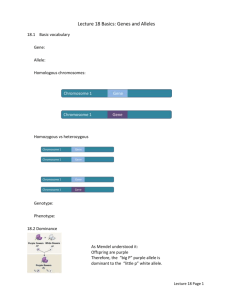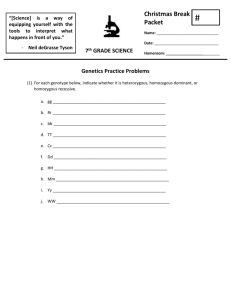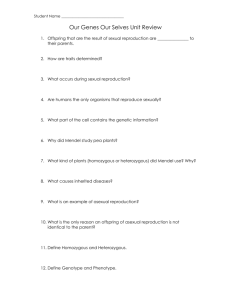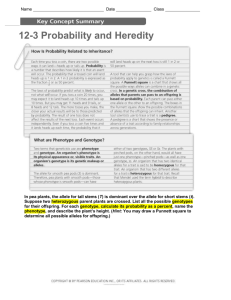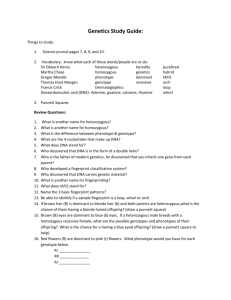Genetics Study Guide
advertisement
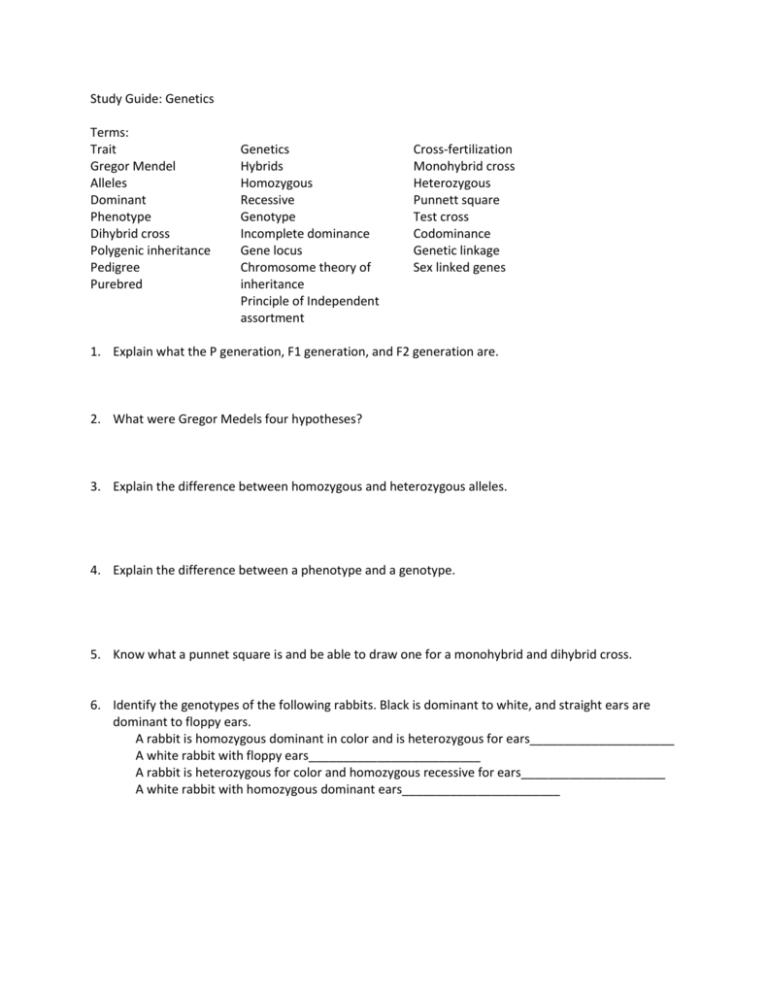
Study Guide: Genetics Terms: Trait Gregor Mendel Alleles Dominant Phenotype Dihybrid cross Polygenic inheritance Pedigree Purebred Genetics Hybrids Homozygous Recessive Genotype Incomplete dominance Gene locus Chromosome theory of inheritance Principle of Independent assortment Cross-fertilization Monohybrid cross Heterozygous Punnett square Test cross Codominance Genetic linkage Sex linked genes 1. Explain what the P generation, F1 generation, and F2 generation are. 2. What were Gregor Medels four hypotheses? 3. Explain the difference between homozygous and heterozygous alleles. 4. Explain the difference between a phenotype and a genotype. 5. Know what a punnet square is and be able to draw one for a monohybrid and dihybrid cross. 6. Identify the genotypes of the following rabbits. Black is dominant to white, and straight ears are dominant to floppy ears. A rabbit is homozygous dominant in color and is heterozygous for ears_____________________ A white rabbit with floppy ears_________________________ A rabbit is heterozygous for color and homozygous recessive for ears_____________________ A white rabbit with homozygous dominant ears_______________________ 7. A man heterozygous for non-attached earlobes (Nn) can roll his tongue. A woman with attached earlobes (nn) can roll her tongue. Assume both are heterozygous for the tongue-rolling trait (Rr) What is the genotype of the mother? __________________ What is the genotype of the father? ___________________ Draw the Punnett square, and combine the gametes to produce offspring What is the phenotypic ratio of these offspring? __________________ 8. In pigs, mule hoof (fused hoof) is dominant (C), while cloven foot is recessive (c). Belted coat pattern (S) is dominant to solid color (s) Draw a Punnett square showing a cross between two dihybrid pigs – they both have the genotype CcSs. What is the phenotypic ratio of the offspring? _____________ 9. Explain the principle of Independent Assortment. 10. What are the exceptions to Mendel’s 4 hypothesis. Explain each. 11. Cross XBXb x XbY What percent of male offspring are colorblind? ___________________ What percent of offspring are carriers of colorblindness? _________________ What percent of female offspring are colorblind? _____________________ 12. Cross XBXb x XBY What percent of male offspring are colorblind? ______________________ What percent of offspring are carriers f colorblindness? _____________________ What percent of female offspring are colorblind? _____________________ 13. Lorax can have red, yellow, or orange fur. The allele that controls this trait is INCOMPLETELY DOMINANT, where orange hair is caused by the heterozygous condition. Show a "key" for the genotypes and phenotypes of hair color. Red_____________ Yellow____________ Orange____________ 14. Lucy lorax has yellow hair she marries Larry lorax with orange hair what are the possible genotypic ratio and phenotypes ratio of their children. Show the punnett square. 15. Linda lorax has red hair and marries lance lorax with yellow hair. What percent of their offspring will have yellow hair__________, red hair_________, and orange hair_____________? Show your punnett square. 16. A bird can have white feathers, blue feathers, and feathers with blue and white. This trait is CODOMINANT. Make a key showing the genotypes using the phenotypes of feather color. Blue_________ White__________ Blue/White_____________ 17. A bird with blue/white feathers is crossed with a blue feather bird what are the genotypic and phenotypic ratios. Show punnett square. List all the different blood types for humans, be able to draw punnett squares using these blood types. 18. Explain genetic linkage. 19. Be able to read a pedigree. What people are affected in each generation ______________________________? Is the affected trait dominant or recessive___________________________ How many females did the generation 1 parents have______________________________? Label the genotypes of everyone in the pedigree using GG, Gg, gg



